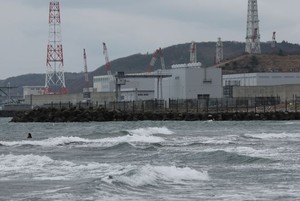August 5, 2023 at 14:06 JST
 The proposed site of the Kaminoseki nuclear power plant in Yamaguchi Prefecture (Kengo Hiyoshi)
The proposed site of the Kaminoseki nuclear power plant in Yamaguchi Prefecture (Kengo Hiyoshi)
Spent nuclear fuel containing radioactive substances will continue to increase as long as nuclear power plants operate.
The government promotes the recycling of nuclear fuel, whereby plutonium extracted from spent nuclear fuel is reprocessed and reused. But the policy has effectively reached an impasse.
The government needs to grasp the difficult reality brought by the operations of nuclear power plants instead of repeatedly turning to stopgap measures over “temporary storage.”
Chugoku Electric Power Co. has announced it is considering building an interim storage facility for spent nuclear fuel on a land plot it owns in Kaminoseki, Yamaguchi Prefecture, where the utility plans to build a nuclear power plant.
The company asked town officials for permission to conduct a feasibility study for the project that it said will be jointly operated with Kansai Electric Power Co.
In Rokkasho, Aomori Prefecture, construction of a nuclear fuel reprocessing facility began 30 years ago. There are no immediate prospects for its completion. Meanwhile, huge amounts of spent nuclear fuel have been accumulating at nuclear power plants around the country.
Kansai Electric’s three old nuclear plants in Fukui Prefecture are of particular concern. Storage pools for spent nuclear fuel are expected to be filled in five to seven years.
The company had promised the Fukui prefectural government it would secure a site to build an interim storage facility outside of the prefecture by the end of the year.
But the utility has failed to make good on its pledge and said it will be shipping a small portion to France instead.
Meanwhile, Chugoku Electric said it approached Kansai Electric after concluding it would be difficult to build and operate an interim storage facility on its own. It cited the massive scale and economic feasibility of the project.
The company stressed the plan would contribute to the government’s policy aimed at expanding the storage capacity of nuclear spent fuel through the collaboration of plant operators.
However, it appears that Chugoku Electric only offered a helping hand to Kansai Electric.
In Kaminoseki, Chugoku Electric’s plan to build a nuclear plant came to light in 1982. Preliminary work began in 2009.
But construction work ground to a halt in the aftermath of the 2011 triple meltdown at Tokyo Electric Power Co.’s Fukushima No. 1 nuclear power plant. The project is now in mothballs.
In light of the fact that state subsidies provided to municipalities hosting nuclear plans are dwindling and construction of proposed new nuclear plants remains suspended, Kaminoseki officials had requested that Chugoku Electric consider implementing new local revitalization measures for the town.
It seems that the two utilities proposed to conduct a study for an interim storage facility, seeing the town’s request as a “timely offer.”
It appears to be no different than the framework in which electric companies have built nuclear plants in municipalities faced with difficulties in terms of industry and population.
In Kaminoseki, it has been pointed out that residents were split over the nuclear plant project, created a deep-rooted rift among them.
However, it is said there were signs of a reconciliation after the Fukushima disaster. The mayor at the time called for community development measures by moving forward with a wind power generation project and making other efforts.
It is a matter of concern that the rift will deepen again because of the problem caused by the planned interim storage facility.
Now that the nuclear fuel cycle project has fallen apart, there are fears spent fuel could end up being stored indefinitely in a facility only ever intended as an interim storage site.
It remains unclear how these concerns are being addressed.
The Kishida administration changed course and decided to seek “maximum utilization” of nuclear plants without a clear vision. The utilities were only too happy to follow its lead.
They must realize how irresponsible they are.
--The Asahi Shimbun, Aug. 5




















A peek through the music industry’s curtain at the producers who harnessed social media to help their idols go global.
A series based on diplomatic documents declassified by Japan’s Foreign Ministry
Here is a collection of first-hand accounts by “hibakusha” atomic bomb survivors.
Cooking experts, chefs and others involved in the field of food introduce their special recipes intertwined with their paths in life.
A series about Japanese-Americans and their memories of World War II